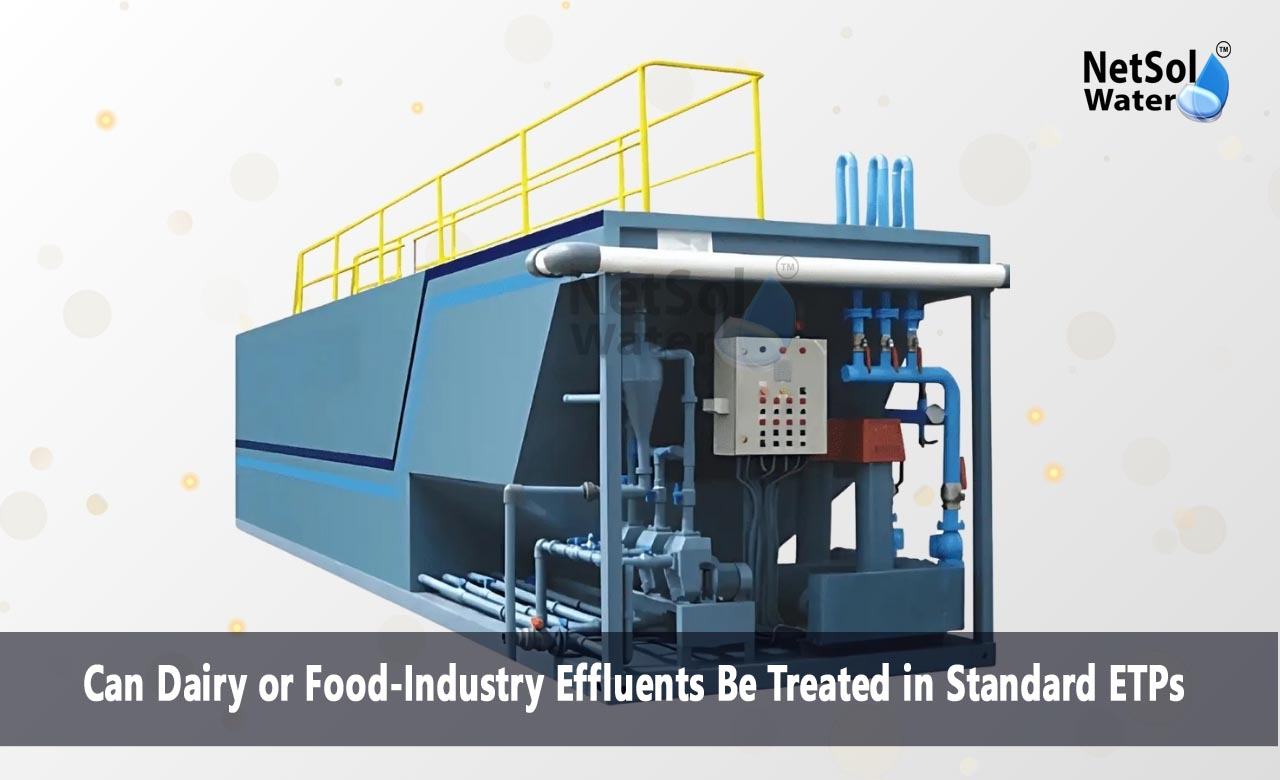Can Dairy or Food-Industry Effluents Be Treated in Standard ETPs?
Effluent from dairy and food plants poses a risk to water bodies. Many operators use standard effluent treatment plants to manage wastewater and ensure compliance with discharge norms. We will discusses if dairy or food-industry effluents can fit into standard ETPs without major redesign. Netsol Water leads the way as a manufacturer of strong water treatment systems. The company crafts modular skid units that adapt to diverse waste streams. Each unit can handle variations in flow and pollutant levels. In this blog we present an overview of the key factors that affect treatment of dairy or food-industry effluents in a typical ETP
Composition and Variability of Effluents
Understanding the make up of dairy or food-industry effluents helps us gauge the load on a treatment plant. Every plant may face a different mix of pollutants depending on its process lines and cleaning methods. Let us have a look at some key factors
Organic Load
This fraction includes fats, proteins and sugars that enter the waste stream during processing. High organic content can strain a biological system if it changes too fast or if the microbes lack food. A stable feed helps maintain healthy biomass.
Nutrient Concentration
Milk and vegetable waste bring nitrogen and phosphorus into the effluent. These nutrients can cause eutrophication if they slip past the final clarifier. Standard ETPs can reduce nutrients but they must tune aeration and biomass to match peak loads.
Solid Particles
Suspended solids include milk curds pulp fragments and cleaning residues from pipes. These particles can block filters and foul membranes. Screening and settling stages in a standard plant must use the right mesh size and detention time to trap solids before they reach the bio tank.
Each of these factors can shift with season sales and cleaning cycles. A well designed ETP can adjust to these swings with simple controls.
Standard ETP Process Suitability
A typical ETP features primary sedimentation followed by a biological step and then polishing. This layout can work for dairy or food-industry effluents when we apply the right design care.
Let us have a look at some process steps
Primary Treatment
In this step we remove large particles and free oil. A coarse screen protects pumps and valves. A grit chamber and a settling tank then trap heavier solids. With a screen size matched to the plant flow a standard unit can cut solids by over fifty percent.
Secondary Treatment
Here the effluent enters an aeration tank or biofilm reactor. Microbes digest organic matter and reduce biological oxygen demand. We keep the mixed liquor suspended solids at an optimal range to ensure good contact. With proper airflow control a standard activated sludge unit can handle spikes in organic load.
Tertiary Treatment
After biological treatment the water moves to clarification or membrane filtration. Here we polish the effluent to meet discharge limits for suspended solids and turbidity. A slow sand filter or a membrane skid from Netsol Water can ensure final clarity.
By sizing each stage for the expected load we can treat most dairy or food-industry effluents in a standard layout without extra tanks.
Challenges and Adaptations Needed
Even a standard ETP may need tweaks to run smoothly under high load or variable waste conditions. Understanding common issues helps us plan small upgrades.Let us have a look at some common issues
Variable pH Levels
Cleaning agents and rinse water can shift pH outside the neutral range. Microbes slow down when pH drops below six or rises above eight. A small dosing pump for acid or alkali keeps the pH in range without overbuilding the plant.
High Solids Content
Some processes sweep solids directly to drains when cleaning tanks. This surge can overwhelm the primary clarifier. A buffer tank with mixing action can even out peaks so the downstream steps run at design load.
Seasonal Flow Changes
A plant may run at low capacity in off season and at full tilt during peaks. Standard ETPs lose performance if we run below their minimum flow. Installing a recirculation line helps maintain steady hydraulic load.
These simple adaptations let a standard plant handle shifts in feed quality and flow without adding major process lines. Netsol Water can supply the pumps, mixers and control panels to integrate these features smoothly.
Conclusion
Can dairy or food-industry effluents be treated in standard ETPs? Yes they can when we size each stage correctly and when we add small adaptations for pH control solids buffering and flow balance. Netsol Water proves its role as a leading manufacturer by delivering modular ETP units that meet these needs. We guide you from initial design to commissioning and follow up with service support.
If you want more information on treating dairy or food-industry effluents reach out to Netsol Water today. Request a consultation and secure reliable compliance and clean water discharge.
Contact Netsol Water at:
Phone: +91-9650608473, Email: enquiry@netsolwater.com



